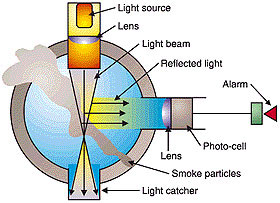By Mike DeMars — Fire Inspector Central Fire Protection District

Photoelectric alarms use a light beam and a photocell to detect smoke. Inside of the alarm is a small chamber where the light source shines on a photocell creating an electrical circuit. Smoke from a fire will enter the chamber. The particles deflect the light beam, breaking the electrical circuit and activate the alarm. This type of alarm works best to detect smoldering type fires. A smoldering fire will burn slowly over a long period before visible flame is evident. An example of a smoldering fire would be a cigarette burning in the cushion of a piece of furniture.
Ionization type smoke alarms use a small particle of radioactive material to operate. Air molecules within the alarm become ionized and allow an electric current to pass between two electrodes in an ionization chamber. The entrance of smoke particles into the chamber will disrupt the electric current and cause the alarm to sound. This type of alarm is effective in detecting smoke from a flaming or fast moving fire such as burning paper or flammable liquid. Ionization alarms are more sensitive to the invisible products of combustion such as vapors or gases produced by fire. They are also prone to more false alarms than photoelectric detectors due to their increased sensitivity. The radioactive material is sealed in a metal chamber within the device. As long as the alarm remains intact, there is little chance of exposure.
Both types have been tested under various fire conditions and have proven to be effective. The purpose of a smoke alarm is to provide you and your family with an early warning so that you can escape a fire in your home before you become trapped. Both types of detection technology provide adequate warning time. Again, one of the differences is that each type of alarm reacts to different stages or types of fire. It is hard to predict what type of fire may occur in your home. A fire in the kitchen may be a flaming fire and a bedroom fire could be a smoldering fire.
How many smoke alarms do you need in your home? That would be dependent on several factors. How many bedrooms are in your home? There should be a smoke alarm in each bedroom. How many stories are in your home? At least one smoke alarm should be installed on each level. Are there hallways adjacent to the bedrooms? Smoke alarms should be installed there as well.
There are also areas where smoke alarms should not be installed. They are not required in kitchens. Although kitchen fires are most common in single-family homes, cooking vapors are the most common cause of false alarms. The hallway adjacent to the kitchen would be a better location. Bathrooms are a bad location because shower steam will activate most alarms.
Now back to the original question. Which type of alarm should you install in your home? The answer may be to use both types of alarms in the home. The two different types of alarms detect different types of fires and both would be beneficial. There are alarms available that use both types of technology in one device. Being that it is hard to predict what type of fire may occur in the home, this may be the best level of protection. Installing both types of alarms in different locations, where they would be most effective, would also be a good idea.
Both types of alarms, ionization and photoelectric, have been tested under various fire conditions and have been proven to provide adequate early warning of fire. The most important thing is to have working smoke alarms, of either type, in your home. The alarms should be tested once a month and the batteries should be replaced at least once a year.